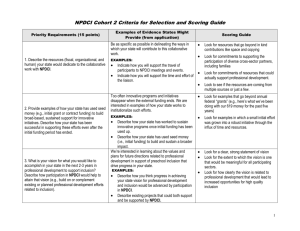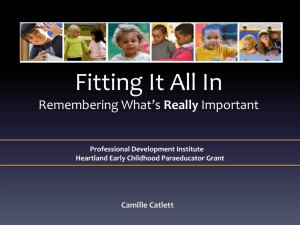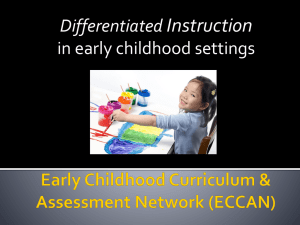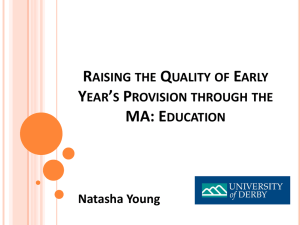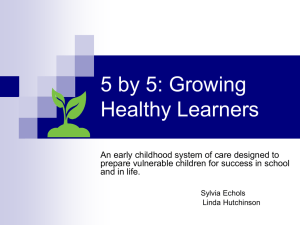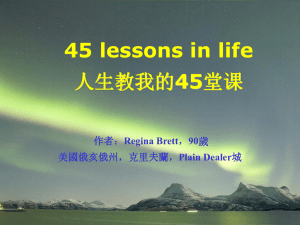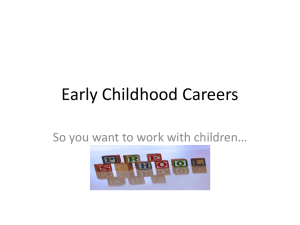A Great Early Childhood Education Workforce
advertisement
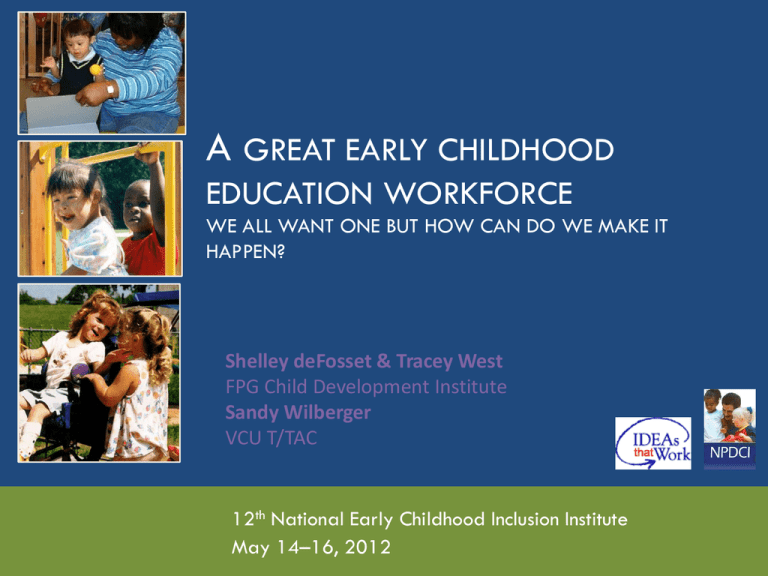
A GREAT EARLY CHILDHOOD EDUCATION WORKFORCE WE ALL WANT ONE BUT HOW CAN DO WE MAKE IT HAPPEN? Shelley deFosset & Tracey West FPG Child Development Institute Sandy Wilberger VCU T/TAC 12th National Early Childhood Inclusion Institute May 14–16, 2012 Participant Poll What sector do you represent? What is your role? What is NPDCI? The goal of NPDCI is to assist states in developing crosssector professional development plans to increase opportunities for high quality preschool inclusion. For Discussion What is “cross-sector” professional development? Who should be part of the cross-sector system of PD? State Early Childhood Development System Comprehensive health services that meet children’s vision, hearing, nutrition, behavioral, and oral health as well as medical health needs. Early Learning Health, Mental Health and Nutrition Early identification, assessment and appropriate services for children with special health care needs, disabilities, or developmental delays 5 Early care and education opportunities in nurturing environments where children can learn what they need to succeed in school and life. Family Support Special Needs/ Early Intervention Economic and parenting supports to ensure children have nurturing and stable relationships with caring adults. National Context Race to the Top – Early Learning Challenge (RTT-ELC) Early Childhood Advisory Council (ECAC) Quality Rating & Improvement Systems (QRIS) Early Childhood Outcome Reporting BUILD (Early Childhood Systems Working Group) Early Childhood Registries Multiple Quality Initiatives Inclusion: DEC & NAEYC Joint Position Statement on Inclusion Quality Movement = Multiple Quality Initiatives 7 accreditation criteria Fiefdoms of Early Childhood Collaborative Approach to PD Health Collaboration: a commitment to work together to address a problem and achieve a goal that could not be accomplished by the organizations working individually (Mattessich et al., 2004) Early Childhood Collaborative PD Initiatives Early Intervention Higher Education Small Group Discussion How could a crosssector system of PD that supports inclusion be beneficial to you in your work? What might be the challenges in building a cross-sector system? The Big Picture Planning Guide is designed to support state-level planning leading to an integrated professional development system across all early childhood sectors. Big Picture Planning Guide: Planning Sequence Step 1: Set the Stage Step 2: Develop a Vision and Focus Areas Step 3: Develop an Implementation Plan Step 4: Create a Structure for Ongoing Improvement Professional Development Who, What and How Planning Matrix (NPDCI, 2011) Part 1: WWH – Learners Who are the major To whom does this funding agencies for agency provide PD? early childhood PD? What is the content of the PD? How is the PD delivered? What is content of the PD for PD providers? How is it delivered? Is this PD integrated with quality initiatives & infrastructure supports? Part 2: WWH – PD Providers Who are the PD providers? Who provides support & resources to the PD providers? Link to infrastructure? Professional Development Planning Matrix For use at state, regional and local level The Matrix provides information that can be used to facilitation and inform discussion of: Unnecessary duplications in PD practices across agencies (e.g., multiple agencies providing PD on the same content areas to the same target audiences without intentional planning)? Gaps in PD efforts (e.g., important content not being addressed in PD, content not aligned with competencies and standards, lack of support for PD providers)? Collaboration across sectors in how PD is funded, planned, and implemented? How could collaboration be improved? Professional Development Planning Matrix Are there unnecessary duplications in PD practices across agencies (e.g., multiple agencies providing PD on the same content areas to the same target audiences without intentional planning)? Are there gaps in PD efforts (e.g., important content not being addressed in PD, content not aligned with competencies and standards, lack of support for PD providers)? Is there collaboration across sectors in how PD is funded, planned, and implemented? How could collaboration be improved? Landscape For Use at the State Level The Landscape provides information about: The PD content that is being addressed most/least often (e.g., general knowledge, practice knowledge) The characteristics of the learners (e.g., level of education, age group served, work settings) The PD approaches that are being used most/least often The level of intensity representative of the majority of the PD provided Virginia’s Story Virginia Cross-Sector Professional Development (VCPD) State Team Membership VA Office of Early Childhood Development ( EC AC) VA Department of Education VA Department of Health VA Department of Social Services VA Resource and Referral Network VA Part C Office VA Integrated Training Collaborative Virginia Cross-Sector Professional Development (VCPD) State Team Membership, con’t The ARC of VA Partnership for People with Disabilities (UCEED) Head Start Collaboration Office VA Early Childhood Foundation VA State Technical Assistance Centers VA Institutes of Higher Education VA Military Childcare VA Star Quality Rating Initiative Accomplishments of VCPD Formation of an active, engaged cross-sector forum of all relevant PD providers in VA that includes a statement of purpose and a letter of agreement A systematic statewide exploration of the status of Early Childhood PD in Virginia through NPDCI tools (Landscape and Matrix) Examination of gaps and coordination of new PD initiatives: Center for Early Learning and Literacy (CELL),Center for Social Emotional Foundations for Early Learning (CSEFEL) and SpecialQuest(SQ), with these Initiatives building off each other’s efforts Two cross sector train-the-trainer initiatives(CELL and SQ) Accomplishments con’t More communication between pre-service and in-service through new Federal Office of Special Education Programs (OSEP) paraprofessional grant and SQ Updated the Competencies for EC Professional to support inclusive practices, with interest in incorporating other at-risk populations Assessed needs of state PD from all sectors to develop a statewide collaborative framework/network The expansion of the ECSE Institutes of Higher Education Council to become the Preparing Educators of All Young Children (PEAYC) Group, linking to community Colleges, locality PD providers, and 4 year colleges Virginia’s Landscape In Virginia, a team identified PD providers and these providers were invited via email to complete the Landscape. Response rate VA (n = 256) of those who followed the link in the invitation email to the Web site with details about the survey 69% of the total number invited 33% Results WHO were the learners who participated in PD? Learners Practitioners 91% Administrators 60.00% Family members 34% PD providers 23% VA Specialists Other 25% 7% Practitioners Work Setting Practitioners’ work settings Child care centers and homes 76% Head Start or Early Head Start 67% Private preschools 54% Public Pre-K programs 42% Preschool for children with disabilities (Part B) 30% Early intervention (Part C) 26% Home visiting/family support 22% K and/or primary grades Other 20% 4% Age Groups Served Age groups practitioners served Infants/toddlers 77% Pre-K K-3rd grade or higher 88% 37% Groups Served Groups of children and families practitioners served Low income 89% Diverse race, ethnicity, culture 88% At risk for learning difficulties or 62% Identified disabilities/delays 69% English language learners 66% Children with special health care needs Don't know 2% Characteristics of PD providers Almost all survey respondents were female 96%, Not Hispanic or Latino White 79% Primary Employer Primary employer Local or regional agency 28% Self-employed independent contractor 13% University, college, or community college 18% Federal agency State agency Other 12% 6% 22% VA VSQI 17% InfantToddler Specialist Network 15% VA CCR&R 14% Cooperative extension agencies 1% Other 17% Home Visiting Consortium 2% Head Start 6% Infant & Toddler Connection of VA and ITC 5% T-TACs 11% Child care trainer for VA DSS 12% WHAT was the content of the PD? Topic % Knowledge about children’s development and learning 86% Strategies for improving general classroom practices, learning environments, and program quality to support development and earning for all children 75% Strategies for collaborating, communicating with, and/or supporting families 71% Knowledge about children’s health, safety, and nutrition 59% Content of the PD (con’t) Strategies for improving inclusion, participation, & learning for children… % At risk for learning disabilities or with challenging behaviors 50% With identified disabilities 54% From diverse cultural and linguistic groups 42% Content of the PD (con’t) Content % Strategies for communicating and collaborating with other professionals 53% Assessment approaches 45% Other 12% How were PD activities delivered ? Type of PD Activities % Workshops or institutes 94% Consultation 47% Mentoring 49% Coaching 44% Technical assistance 50% Distance learning approaches 50% COPs/practitioner study groups 23% Co-teaching 14% Other 3% Recommendations for Strong Cross Sector State Infrastructure A coordinated needs assessment process Accessibility and availability of early childhood credential and licensure A career lattice that is broad and aligned A cross-sector trainer registry Coordinated PD standards: trainer competencies and content State policies and regulations that support a coordinated system Recommendations (cont.) Recruitment & retention (tiered reimbursement, scholarships, incentives, etc.) Content aligned with other local, state & federal standards across sectors A training and technical assistance structure to support mentoring & coaching (for providers and recipients of PD) Aligned ECE professional competencies Unified birth-five licensure for all early childhood educators Articulation from entry level training through higher education. Regional Professional Development Consortiums PD Consortiums coordinated out of the following cities: Fairfax, Richmond, Harrisonburg, Blacksburg and Norfolk. Consortium Tasks Identify priorities through routine needs assessments Develop a work plan to address identified regional needs Convene quarterly regional consortium meetings (F2F or virtual) Develop and maintain a Web site for their region Coordinate and promote cross-sector regional trainings Regional Professional Development Consortiums PD Consortiums coordinated out of the following cities: Fairfax, Richmond, Harrisonburg, Blacksburg and Norfolk. Consortium Tasks, con’t Coordinate distance learning opportunities with other consortiums Maintain a list of trainers that provide training on special initiatives (i.e., SpecialQuest, CSEFEL, etc.) Maintain communication with other regions to maximize use of resources and expertise across regions Participate in activities coordinated by State Lead and VCPD Regional consortium leads will attend an annual planning meeting. Professional Development Who, What and How Planning Matrix (NPDCI, 2011) Part 1: WWH – Learners Who are the major To whom does this funding agencies for agency provide PD? early childhood PD? What is the content of the PD? How is the PD delivered? What is content of the PD for PD providers? How is it delivered? Is this PD integrated with quality initiatives & infrastructure supports? Part 2: WWH – PD Providers Who are the PD providers? Who provides support & resources to the PD providers? Link to infrastructure? Small Group Discussion How could these tools be used to support your work around building a professional development system that supports inclusion? Additional Resources Early Childhood Inclusion: A Joint Position Statement of DEC and NAEYC Recommendations for States for Linking PD, Quality and Inclusion Research Synthesis Points on Quality Inclusive Practices NPDCI Professional Development Concept Paper The Inclusive Classroom Profile (ICP): Moving Beyond Global Quality The Inclusive Classroom Profile, developed by Elena Soukakou, is a tool designed to complement existing classroom quality measures & standards Reflections I am interested in … I want to know more about …


